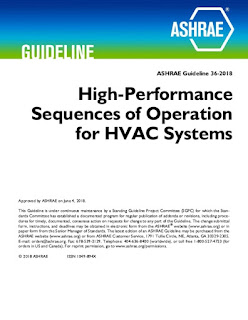ASHRAE Guideline 36-2018
High-Performance Sequences of Operation for HVAC Systems
Standardized advanced control sequences provide benefits including reduced engineering time, reduced programming and commissioning time, reduced energy consumption, improved indoor air quality, and a common set of terms to facilitate communication between specifiers, contractors, and operators
1 Purpose
2 Scope
3 Set Points, Design, and Field Determined
3.1 Information Provided by Designer
3.2 Information Provided by (or in Conjunction with) the Testing, Adjusting, and Balancing Contractor
4 List of Hardwired Points
4.1 VAV Terminal Unit—Cooling Only
4.2 VAV Terminal Unit with Reheat
4.3 Fan-Powered Terminal Unit (Series or Parallel, Constant- or Variable-Speed Fan)
4.4 Dual-Duct Terminal Unit with Inlet Sensors
4.5 Dual-Duct Terminal Unit with Discharge Sensor
4.6 Multiple-Zone VAV Air-Handling Unit.
4.7 Dual-Fan Dual-Duct Heating VAV Air-Handling Unit
4.8 Single-Zone VAV Air-Handling Unit
5 Sequences of Operations.
5.1 General .
5.2 Generic Ventilation Zones .
5.3 Generic Thermal Zones .
5.4 Zone Groups .
5.5 VAV Terminal Unit—Cooling Only .
5.6 VAV Terminal Unit with Reheat .
5.7 Parallel Fan-Powered Terminal Unit—Constant-Volume Fan .
5.8 Parallel Fan-Powered Terminal Unit—Variable-Volume Fan.
5.9 Series Fan-Powered Terminal Unit—Constant-Volume Fan .
5.1 0 Series Fan-Powered Terminal Unit—Variable-Volume Fan .
5.1 1 Dual-Duct VAV Terminal Unit—Snap Acting Control .
5.1 2 Dual-Duct VAV Terminal Unit—Mixing Control with Inlet Airflow Sensors .
5.1 3 Dual-Duct VAV Terminal Unit—Mixing Control with Discharge Airflow Sensor.
5.1 4 Dual-Duct VAV Terminal Unit—Cold-Duct Minimum Control .
5.1 5 Air-Handling Unit System Modes
High-Performance Sequences of Operation for HVAC Systems
Full Description
ASHRAE Guideline 36 provides uniform sequences of operation for HVAC systems that are intended to maximize the systems' energy efficiency and performance, provide control stability, and allow for real-time fault detection and diagnostics.Standardized advanced control sequences provide benefits including reduced engineering time, reduced programming and commissioning time, reduced energy consumption, improved indoor air quality, and a common set of terms to facilitate communication between specifiers, contractors, and operators
CONTENTS
2 Scope
3 Set Points, Design, and Field Determined
3.1 Information Provided by Designer
3.2 Information Provided by (or in Conjunction with) the Testing, Adjusting, and Balancing Contractor
4 List of Hardwired Points
4.1 VAV Terminal Unit—Cooling Only
4.2 VAV Terminal Unit with Reheat
4.3 Fan-Powered Terminal Unit (Series or Parallel, Constant- or Variable-Speed Fan)
4.4 Dual-Duct Terminal Unit with Inlet Sensors
4.5 Dual-Duct Terminal Unit with Discharge Sensor
4.6 Multiple-Zone VAV Air-Handling Unit.
4.7 Dual-Fan Dual-Duct Heating VAV Air-Handling Unit
4.8 Single-Zone VAV Air-Handling Unit
5 Sequences of Operations.
5.1 General .
5.2 Generic Ventilation Zones .
5.3 Generic Thermal Zones .
5.4 Zone Groups .
5.5 VAV Terminal Unit—Cooling Only .
5.6 VAV Terminal Unit with Reheat .
5.7 Parallel Fan-Powered Terminal Unit—Constant-Volume Fan .
5.8 Parallel Fan-Powered Terminal Unit—Variable-Volume Fan.
5.9 Series Fan-Powered Terminal Unit—Constant-Volume Fan .
5.1 0 Series Fan-Powered Terminal Unit—Variable-Volume Fan .
5.1 1 Dual-Duct VAV Terminal Unit—Snap Acting Control .
5.1 2 Dual-Duct VAV Terminal Unit—Mixing Control with Inlet Airflow Sensors .
5.1 3 Dual-Duct VAV Terminal Unit—Mixing Control with Discharge Airflow Sensor.
5.1 4 Dual-Duct VAV Terminal Unit—Cold-Duct Minimum Control .
5.1 5 Air-Handling Unit System Modes
5.1 6 Multiple-Zone VAV Air-Handling Unit .
5.1 7 Dual-Fan Dual-Duct Heating VAV Air-Handling Unit .
5.1 8 Single-Zone VAV Air-Handling Unit.
Informative Appendix A: Control Diagrams .
Informative Appendix B: Abbreviations and Acronyms .
5.1 7 Dual-Fan Dual-Duct Heating VAV Air-Handling Unit .
5.1 8 Single-Zone VAV Air-Handling Unit.
Informative Appendix A: Control Diagrams .
Informative Appendix B: Abbreviations and Acronyms .














No comments